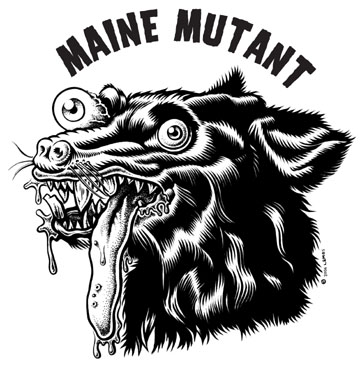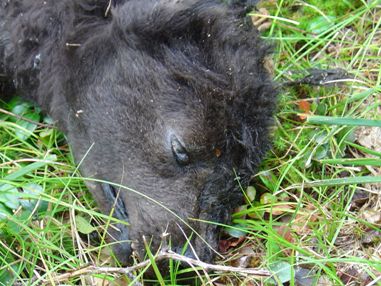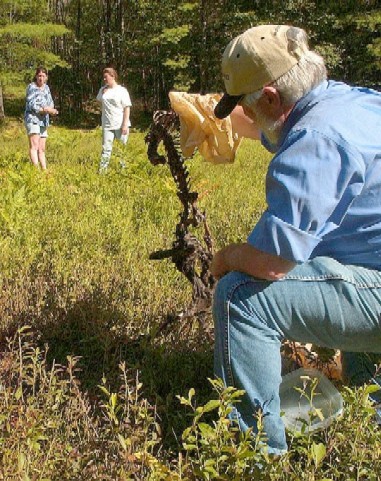Gone Where The Goblins Go
Posted by: Loren Coleman on September 2nd, 2006
Ding-dong the dog is dead
Which old dog? The wicked dog
Ding-dong the wicked dog is dead
Wake up you sleepyhead
Rub your eyes, get out of bed
Wake up the wicked dog is dead
He’s gone where the goblins go.
The story of the Maine Mutant or Mystery Beast of Turner, Maine, has just begun. Scholars, scoundrels, and skeptics will write about the case for years, attempting to prove that it says something sinister about the gullibility of humans. But the story is one deeper than that, of media, madness, and mayhem, of jealousy, joining, and journeys.
But we’ve got to verify it legally
To see…
To see…
If he…
If he…
Is morally, ethically
Spiritually, physically
Positively, absolutely
Undeniably and reliably dead
As Coroner , I thoroughly examined him
And he’s not only merely dead
He’s really most sincerely dead.
I most sincerely send my apologies out to the Munchkins, Dorothy, and the Wizard of Oz, but I am using the word “wicked” in the sense that Mainers do, i.e. “wicked” = “something that is very, very good.” Yes, the wicked dog is dead, the wicked dog of the East is most sincerely dead. The wicked animal was a male dog. But he was much, much more.
Mark LaFlamme, the investigative reporter at the Sun Journal in Lewiston, Maine, was the author of this story on many levels. But the worldwide media took the story from him and made it their own. The people of Turner, then the state of Maine did likewise. This became the “Maine Mutant,” in creative art, in watercooler chat, in talks at the local post office, and across the internet. Soon the Mutant grew larger and larger, this monster of a story. Chronologies were confused, descriptions overblown, and the true mystery lost in the debate about the dead animal on the road.
Interestingly, at the almost very end, as the DNA findings began filtering in, I saw that Mark LaFlamme momentarily lost control of telling the tale at his own paper. LaFlamme was preempted by the unexplainable move on the part of the city editor who rushed to put her own spin on the DNA results via the paper’s online edition late Friday night. That summary would become the AP dispatch sent round the globe, thus shutting LaFlamme out of a final, broader telling of the tale. Nevertheless, LaFlamme has taken the time to record his last words on this chapter of the story in Saturday’s (September 2, 2006) edition of the same newspaper.
LaFlamme’s article, “Verdict: It’s A Dog” begins:
TURNER – A dead animal found beneath power lines off Route 4 last month was 100 percent dog, according to the final DNA analysis completed Friday. It was not a werewolf. It was not a mutation. It was not some exotic species unknown to mankind.
It was a dog. And not even a dog-wolf hybrid, as many had guessed.
“There are no traces of wolf in this animal,” said Dr. Yuri Melekovet, laboratory director at HealthGene Corp. in Toronto. “There would have been evidence of that in the genome.”
There was no trace of human in the DNA or of something extraterrestrial either, Melekovet said. The so-called mystery creature that galvanized the community and the rest of the country last month was unremarkable in its lineage.
It remained unknown Friday what kind of dog the animal was. There are tests to make such determinations, but they are extensive, costly and time-consuming. Melekovet believes such tests would be irrelevant.
“If you say this is a half-dog, half-human, people will say, ‘Wow!'” he said. “If you say this is a dog, they won’t care so much.”

The logo art that came to symbolize the wicked beast, the Maine Mutant by Mike Lemos who lives far, far away in Ventura, California.
The findings will likely result in an echo of “I told you so” across the area. Since the strange-looking animal was found Aug. 12, many have insisted the beast was nothing more than a common dog. They did so in the face of those who believed the dead animal was the mystery creature that has been startling people in Western Maine for more than a decade.
If there was any consolation for believers Friday, it was that the real creature may still be out there, alive and elusive as ever.
“The creature still in the Central Maine woods remains the real mystery beast, and the poor dead dog hit by a car on Route 4 was the shadow pretender,” said cryptozoologist Loren Coleman, who examined the Turner animal and declared it a dog two weeks ago. “Of course it was a dog,” he said. “But that dog story became a worldwide media event and is already a major candidate for one of the top 10 cryptozoology stories of 2006.”
LaFlamme had been there in 2004 and 2005, and knew that the locals had seen something huge and horrible. In the September 2nd piece he launches into a long section of retelling the story of a man, Tom Merriam, a wildlife photographer from Windham, who feels he met and fed the wild dog, the one that would end up dead on Route 4, a ham-and-cheese sandwich over the summer. Maybe Merriam did, maybe he didn’t. It is merely another sighting, a part of the mystic of this tale.
LaFlamme goes on to have a flashback moment, noting the dog had a “celebrity look” to it, so much so that this became the root of the story:
When the animal was first discovered, the woman who found the carcass took photos of it. Those photos ended up on television news stations and countless Web sites across the world. Michelle O’Donnell, who took the photographs, said she saw the beast a week before it was struck by a car and killed. And she insisted, like others, that it looked like no dog she had ever seen.
The three photographs of the dead animal above are all by Michelle O’Donnell; click on any to enlarge. Used by permission.
The reporter was always level-headed about the events, even in the middle of the media hurricane. LaFlamme and I talked often, and he ends his piece with these concluding words:
According to Coleman, the cryptozoologist, the hunt continues for the real mystery beast. The hype about the Turner animal at least brought focus to his profession and resulted in lively debate among the local population.
“This was no hybrid, no mutant, no mystery,” Coleman said. “This was a case where international cryptozoology triumphed, where a creature was recognized as nothing bizarre, but also acknowledged as not the mysterious one that previously had been sighted.”
In other words, the truth is still out there.
The Carcass and the Cryptozoologist.

The untrimmed dew claws of the animal – a feral dog – killed by a car, and discovered alongside Route 4, Turner, Maine.
Both photographs here at the end by Sun Journal photographer Douglas Van Reeth. Used by permission. Click to enlarge either.
About Loren Coleman
Loren Coleman is one of the world’s leading cryptozoologists, some say “the” leading living cryptozoologist. Certainly, he is acknowledged as the current living American researcher and writer who has most popularized cryptozoology in the late 20th and early 21st centuries.
Starting his fieldwork and investigations in 1960, after traveling and trekking extensively in pursuit of cryptozoological mysteries, Coleman began writing to share his experiences in 1969. An honorary member of Ivan T. Sanderson’s Society for the Investigation of the Unexplained in the 1970s, Coleman has been bestowed with similar honorary memberships of the North Idaho College Cryptozoology Club in 1983, and in subsequent years, that of the British Columbia Scientific Cryptozoology Club, CryptoSafari International, and other international organizations. He was also a Life Member and Benefactor of the International Society of Cryptozoology (now-defunct).
Loren Coleman’s daily blog, as a member of the Cryptomundo Team, served as an ongoing avenue of communication for the ever-growing body of cryptozoo news from 2005 through 2013. He returned as an infrequent contributor beginning Halloween week of 2015.
Coleman is the founder in 2003, and current director of the International Cryptozoology Museum in Portland, Maine.














I’m baffled by this. So this animal is a 100 percent dog? So if this chapter has come to a close, why are researchers still insisting its still something else? This is very confusing. At first my observation of the animal, I thought it looked like a werewolf. Then I thought I was wrong. Anyway, they already determined it was a dog by doing the DNA testing, but now this story seems like it hasn’t come to a close. They still keep coming back to this story.
“…they still keep coming back to this story.”
Well…seems no one likes being wrong (and everyone ADORES being right!). I think this might be where the term ‘beating/kicking a dead horse’ or, in this case ‘beating/kicking a dead dog’ comes from…
My, my, my….how the media have effected our society…
crypto-randz: I’m not sure of the source of your confusion. No, the dead dog was not a werewolf.
The animal reported in the woods (1991-2005) appears to be and most sincerely is different that the dog found on the road.
I’m not sure who “they” are, either.
The reporter, yours truly, and a few others have been clear about the differences between the cryptid sightings from years before, and the recent nature of this flap in which this dead animal killed in August 2006 was blamed for the earlier sightings. But the dead animal (labeled “Mystery Beast” unfortunately) was only a dog, not a monster, and very small.
How is this unclear and confusing?
I wonder what kind of dog it is. It’s “100% dog”, but what kind? (I know, tests for that would be expensive.) Any ideas? Still Chow, or something? It looks very weird to me–then again, dogs are allowed to look weird.
I tought it was very clear from the start this was a dog and nothing else. Good Job Loren.
Also last night while channel surfing saw you on the travel Channel on Lake Monsters and then saw you and Craig on the Big Fellow. Even though I have seen almost all these type of shows it is like In Search Of or Arthur Clarks shows I still sit there and watch them again and again.
It couldn’t be a Werewolf…
Don’t they turn back into human form after they die? woof woof… 😉
hhahahahahahah Yeah your right but I figured the dragon part took that away.
Can’t be a werewolf. Don’t they turn back to human once killed?
Loren, I saw you also on weird travels. I saw that episode a couple times before, good job by the way.
What I meant was I thought the dog looked like a werewolf, but I was wrong. Also I meant if it is a dog, why are experts still discussing it? This story should be closed, but I do agree with yardstick, the dog does look quite a mixture of different dogs. This is just my opinion.
It’s interesting because the stories of a mysterious beast in the woods helped to propel this mundane little doggy to stardom. I’m sure if there had been no particular reports of anything unusual in the area, this wouldn’t have gotten so out of hand, and most people would have been comfortable with the verdict that the pictured creature was a dog. This fascinates me because you can have pretty much any medium sized, furry roadkill in Latin America be proclaimed the Chupacabras, when if that happened where I live, it would be just what it seemed to be which is a dead animal of rather mundane origins.
“There is something that is acting to kill off mysteries” (Fort, Lo! Complete Books of… page 660)
“almost anybody,…reading these accounts down to the final one, would say – “Why of course! It’s the way these stories always end up. Nothing to them.”But it is just the way that these stories always end up that has kept me busy…” (Fort, Lo! Complete Books of… page 644)
Charles Fort already wrote profusely about this mechanism: that of the mutilation flap, the predator is not caught despite extensive search parties, then the body of a wolf, dog or otter is found or such an animal is shot, the animal is thought to have been responsible for the mutilation flap, hence the interest in the mutilation flap susbsides, but the flap itself continues, or moves to another geographic locale). See: Lo! (1931) I have quoted and refer to the Complete Books of Charles Fort (Dover edition), pages 643 – 667.
One hundred years ago this winter, a Northumberland town was gripped by panic when a mysterious wolf began attacking local livestock. Charles Fort recorded the case – and much other strangeness in Britain during the winter of 1904/1905 – in his book Lo! STUART FERROL celebrates this centenary with a full account of the hunt for Hexham’s unusual – and unwelcome – visitor.